Guest from the subtropics: what health benefits and harms does feijoa bring?
Content:
In the central part of Russia, few people are familiar with feijoa, the beneficial properties and taste of this exotic fruit. Residents of Europe first discovered the plant in Brazil only in the 19th century, and then transported it to their homeland. Flowering shrubs have become an excellent decoration for gardens, and juicy fruits have become a delicacy and a source of vitamins. In this article, you will get to know feijoa better, learn about its benefits, potential health hazards and contraindications for consumption.
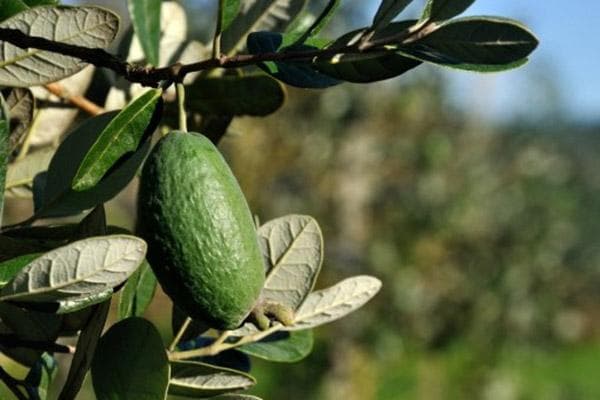
What does feijoa look like and where does it grow?
Feijoa is an evergreen shrub from the Myrtaceae family. It grows up to 4 meters in height, has a densely spreading crown of rounded leaves. At the end of spring, the tree pleases the eye with pink flowers with numerous red stamens. The feijoa trunk is greenish-brown and rough to the touch.
The fruits of the plant resemble large plums. They reach 2–5 cm in length. The peel is dense and green, sometimes with a reddish or purple coating (as it contains anthocyanins). Because of its tart taste, it is rarely eaten.The pulp is of particular interest to gourmets. In ripe fruit it is transparent, sweet, with a slight sourness and a minty trail. It tastes like a mixture of kiwi, strawberry and pineapple. Very juicy and aromatic.
Feijoa grows mainly in countries with a subtropical climate. In particular, it is common in the following regions:
- South America: Brazil, Argentina, Uruguay, Paraguay;
- Crimea, Abkhazia, Georgia, Krasnodar region of Russia;
- France, Greece, Spain, Portugal;
- on the Pacific coast of the USA;
- Australia and New Zealand.
On the Russian market, green fruits can be bought throughout the fall and early winter.
Chemical composition and calorie content of feijoa
Scientists have discovered more than 90 useful substances in feijoa. Among them are vitamins, macro- and microelements, organic acids, anthocyanins and flavonoids. The calorie content of 100 g of fruit is only 60–70 kcal. Therefore, the product can be safely included in the diet. Let's consider which valuable chemical compounds predominate in the composition.
- Vitamin C
There is almost as much vitamin C in feijoa as in lemons - 1/3 of the daily requirement. This substance supports strong immunity, has a positive effect on blood circulation and skin condition. In men, vitamin C prevents blood stagnation in the pelvic organs and improves sexual function.
- Vitamin B9 (folic acid)
The presence of folic acid makes feijoa a very valuable fruit for women. When consuming fresh fruits, the production of red blood cells increases, which improves the condition during menstruation. In pregnant women, folic acid normalizes hormonal levels, prevents intrauterine pathologies and premature birth.
- Vitamin B5
Vitamin B5 allows a person to feel vigorous, cheerful, and productive. It is also able to enhance the production of glucocorticoid hormones, which reduce inflammation in the body.
- Potassium
Potassium is one of the most important macronutrients for heart health. By regulating the water-salt balance in the body, it maintains normal heart rate and blood pressure, and eliminates excess fluid.
- Silicon
100 g of feijoa fruit contains 43% of the daily requirement of silicon. This macroelement resembles calcium in its properties: it is used to build bones, cartilage, teeth, and nails.
- Iodine
In terms of bioavailable iodine content, only seafood can compare with feijoa. The closer to the sea the bush grows, the more substance it contains.
Iodine maintains normal thyroid function because it is involved in the production of two hormones - thyroxine and triiodothyronine. If there is a lack of this microelement, a person runs the risk of hypothyroidism, slow metabolism and obesity. Iodine is also useful because it increases mental abilities.
- Chromium
Chromium is a trace element that enhances the action of the hormone insulin and thereby lowers blood sugar levels. 100 g of feijoa contains 14% of the daily requirement of this substance. The fruits can be included in the diet to prevent type 2 diabetes and control appetite.
Beneficial properties of feijoa
When consumed regularly, feijoa has a healing effect on internal organs. Below we will consider for what ailments and characteristics of the body it is useful to eat it.
- For digestive problems
Feijoa contains a lot of dietary fiber, which normalizes intestinal motility. And organic acids in the product stimulate the production of gastric juice.Green fruits are useful for people with a sluggish appetite and those who want to get rid of constipation.
- With low thyroid function
Mood swings, constant feeling of fatigue, drowsiness, rapid weight gain for no reason - these are typical symptoms of a malfunction of the thyroid gland. Feijoa helps normalize hormonal levels and improve well-being, as it contains a lot of iodine.
- In inflammatory processes in the body
Doctors recommend eating feijoa for people suffering from gout, pyelonephritis, gastritis, ulcerative colitis and other inflammatory diseases. The pulp of the fruit contains vitamin B5, and the seeds contain omega-3 fatty acids. These substances have pronounced anti-inflammatory properties.
- After 40 years
Older people are better off eating feijoa with the peel. It contains catechins and leukoanthocyanins, which neutralize the negative effects of free radicals on the body. Antioxidants slow down the aging process, improve mood and protect the body from cancer.
- In childhood
Feijoa is useful for children because it strengthens the immune system, improves thinking abilities and improves mood. Despite the fact that the fruit is exotic, it rarely causes allergies. Children enjoy eating sweet green fruits.
Harm and contraindications of feijoa
If you abuse feijoa fruits, you risk harming your body. So, when overeating, the following side effects sometimes occur:
- nausea and vomiting;
- diarrhea;
- bloating;
- irritability;
- cardiopalmus.
You should not eat unripe fruits that have white rather than transparent flesh. Due to the high acid content, such fruits irritate the gastric mucosa and cause pain and discomfort.
What are the contraindications for consumption of feijoa? The tropical fruit contains a lot of sugars, so it should not be eaten if you have type 2 diabetes. Overweight people should limit sweet fruits in their diet or eat only in the first half of the day.
If you have thyrotoxicosis (increased thyroid function), you should consult your doctor before using the product. Excess iodine in the diet can negatively affect the well-being of people facing this problem.
How to select and store feijoa?
The maturity of feijoa can be determined by appearance and touch. Good fruits are slightly soft and have no visible defects: cracks, scratches, dark spots. A light coating of red, purple or brown is allowed.
Feijoa should be stored in the lower compartment of the refrigerator for vegetables and fruits for no longer than 7 days. If the fruits are not ripe, leave them in a room at a temperature of 18–23 degrees for 2–3 days.
How to eat feijoa?
In order for the body to receive the maximum vitamins, you need to eat feijoa fresh. Preferably with the peel, as it contains a large amount of useful substances that are almost absent in the pulp (in particular, anthocyanins).
Basically, feijoa is eaten like this:
- Wash the fruit under running water.
- Cut into two parts.
- Use a teaspoon to scoop out the pulp.
It is better not to throw away the seed, as it is easily digested in the stomach. In addition, it contains valuable omega-3 acids.
You can eat up to 300 g of fresh fruits per day without harm to your health. For overweight people and small children, it is recommended to reduce the amount by 1.5–2 times.
How to cook feijoa - recipes
You can make delicious delicacies and aromatic drinks from feijoa. We invite you to familiarize yourself with several interesting recipes.
Vitamin tea
To make tea you will need feijoa leaves. 1 tbsp. Pour a glass of boiling water over a spoonful of crushed raw materials and leave to steep for 30 minutes. Then add a little honey and lemon juice. Tea from feijoa leaves is drunk to treat diffuse toxic goiter, hypovitaminosis, and nephritis. It also helps with reduced immunity.
Green puree
Essentially these are feijoa fruits ground with sugar. Take the components in a 1:1 ratio and grind in a blender. Store the puree in the refrigerator for no longer than 3 months. You can add lemon juice - it will help maintain the green color of the product (otherwise the mixture will turn brown).
Jam
Feijoa jam is a delicious addition to pancakes, buns, and pies. It has a delicate taste and amber color.
To prepare the dessert, prepare the following ingredients:
- feijoa – 0.5 kg;
- sugar – 1 glass;
- cognac or whiskey - 1 tbsp. spoon;
- water – 0.5 l.
Wash the fruits, remove the peel (but do not throw away). Pour sugar into a saucepan, add 1 tablespoon. spoon of water and put on fire. Stir until the powder is completely dissolved and turns golden in color. Boil the remaining water, pour sugar syrup into it and stir. Add the peel to the sweet liquid, bring to a boil and cook for 5 minutes.
Strain the syrup. Discard the peel. Add peeled and chopped feijoa fruits to the syrup. Bring the mixture to a boil and cook, stirring constantly, for 30–40 minutes. A minute before readiness, pour in the alcoholic drink and stir. Pour the jam into sterilized jars.
Smoothie
If you're into healthy eating, try making a smoothie. You will need the following products:
- feijoa – 4 pieces;
- banana - half;
- large apple - half;
- kiwi – 1 piece;
- low-fat yogurt without sugar – 150 ml;
- ground cinnamon.
Cut all the fruits into small pieces. Blend in a blender along with yogurt and cinnamon. Drink a smoothie for breakfast or use as a light snack.
Baked fish with feijoa
Another dietary dish that will diversify your diet. You will need the following products:
- dense fillet of white fish (for example, flounder);
- feijoa – 5 pieces;
- cream – 100 ml;
- orange juice – 100 ml;
- honey – 0.5 tbsp. spoons.
Rinse the fish fillet thoroughly and dry. Remove the pulp from the feijoa fruit using a teaspoon and mash it into a puree. Mix with cream, orange juice and honey. Marinate the fillet and leave for 1 hour.
Place the fish in the oven and bake at 200 degrees for 40 minutes. Garnish the finished dish with crushed walnuts or sunflower seeds.
If you have the opportunity to buy feijoa, do not deny yourself the pleasure. This guest from the subtropics will give you a good mood, high performance and improve your health. The fruit has a pleasant taste both fresh and as part of dishes and drinks. It is also one of the few products that contain enough iodine for the body.
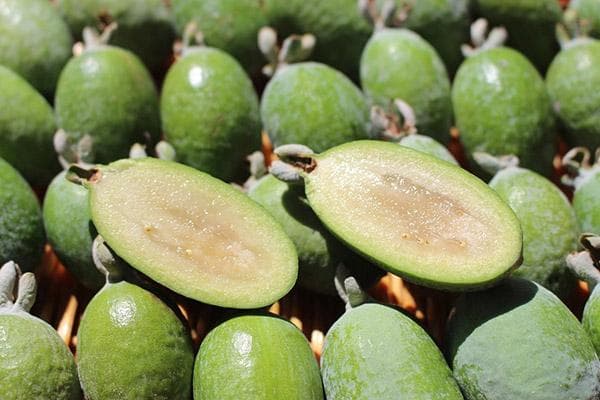
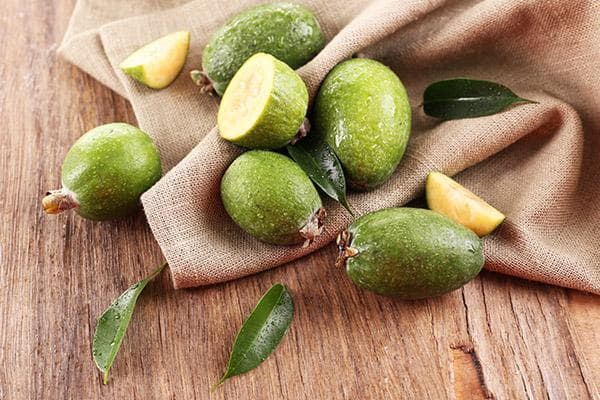
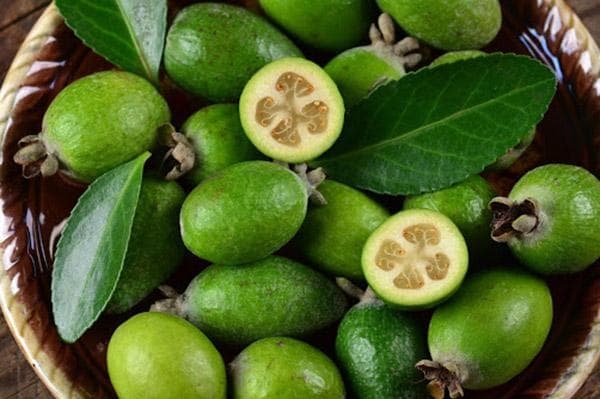
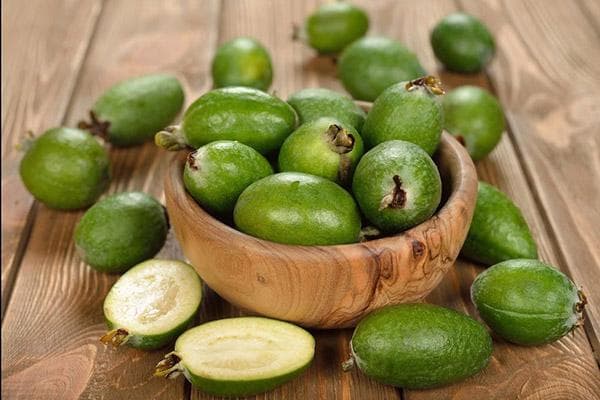
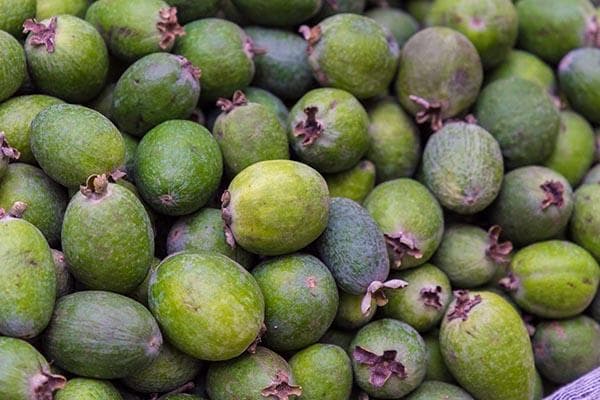
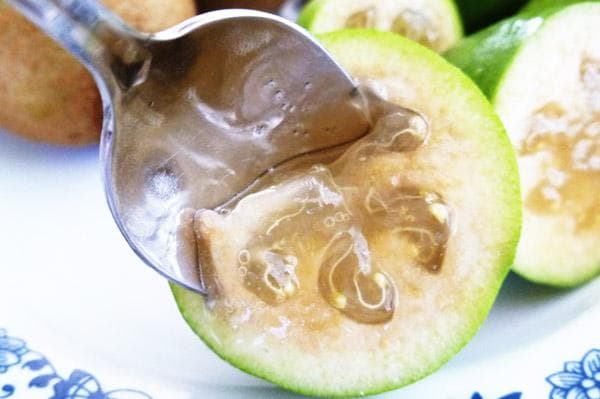

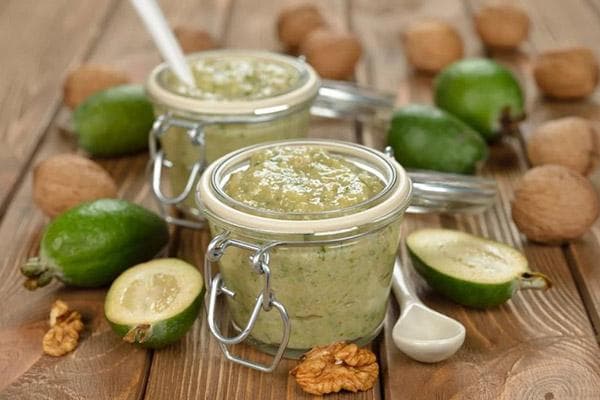
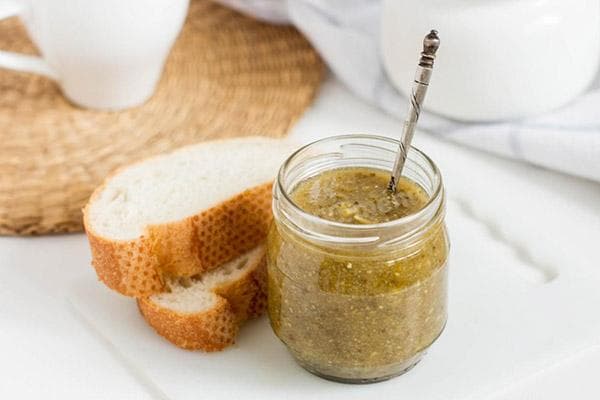
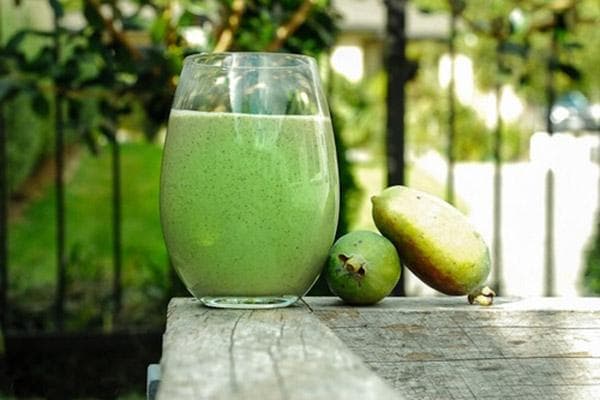
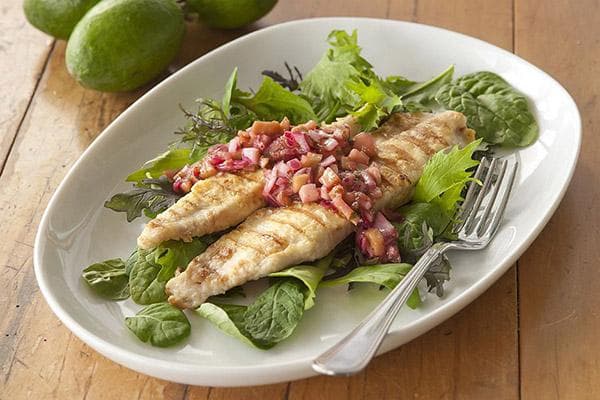
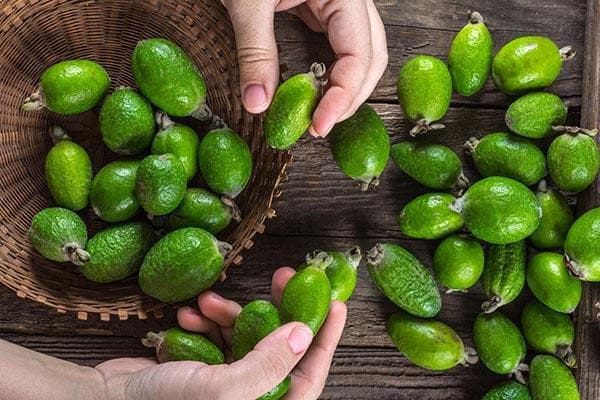
I pick feijoa, the taste is divine